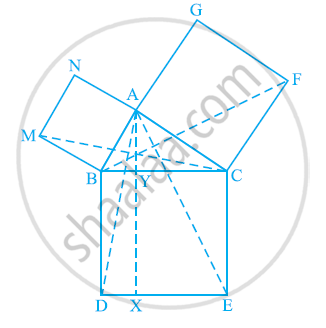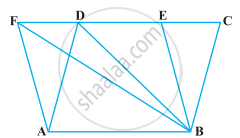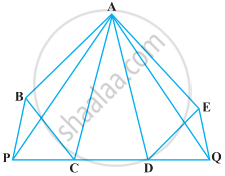Advertisements
Advertisements
प्रश्न
In the following figure, ABC is a right triangle right angled at A. BCED, ACFG and ABMN are squares on the sides BC, CA and AB respectively. Line segment AX ⊥ DE meets BC at Y. Show that:-

(i) ΔMBC ≅ ΔABD
(ii) ar (BYXD) = 2 ar(MBC)
(iii) ar (BYXD) = ar(ABMN)
(iv) ΔFCB ≅ ΔACE
(v) ar(CYXE) = 2 ar(FCB)
(vi) ar (CYXE) = ar(ACFG)
(vii) ar (BCED) = ar(ABMN) + ar(ACFG)
Note : Result (vii) is the famous Theorem of Pythagoras. You shall learn a simpler proof of this theorem in Class X.
उत्तर
(i) We know that each angle of a square is 90°.
Hence, ∠ABM = ∠DBC = 90º
⇒ ∠ABM + ∠ABC = ∠DBC + ∠ABC
⇒ ∠MBC = ∠ABD
In ΔMBC and ΔABD,
∠MBC = ∠ABD (Proved above)
MB = AB (Sides of square ABMN)
BC = BD (Sides of square BCED)
∴ ΔMBC ≅ ΔABD (SAS congruence rule)
(ii) We have
ΔMBC ≅ ΔABD
⇒ ar (ΔMBC) = ar (ΔABD) ... (1)
It is given that AX ⊥ DE and BD ⊥ DE (Adjacent sides of square
BDEC)
⇒ BD || AX (Two lines perpendicular to same line are parallel to each other)
ΔABD and parallelogram BYXD are on the same base BD and between the same parallels BD and AX.
∴ ar(ΔABD) = 1/2ar(BYXD)
ar(BYXD) = 2ar(ΔABD)
Area (BYXD) = 2 area (ΔMBC) [Using equation (1)] ... (2)
(iii) ΔMBC and parallelogram ABMN are lying on the same base MB and between same parallels MB and NC.
∴ ar(ΔMBC) = 1/2ar(ABMN)
2ar (ΔMBC) = ar (ABMN)
ar (BYXD) = ar (ABMN) [Using equation (2)] ... (3)
(iv) We know that each angle of a square is 90°.
∴ ∠FCA = ∠BCE = 90º
⇒ ∠FCA + ∠ACB = ∠BCE + ∠ACB
⇒ ∠FCB = ∠ACE
In ΔFCB and ΔACE,
∠FCB = ∠ACE
FC = AC (Sides of square ACFG)
CB = CE (Sides of square BCED)
ΔFCB ≅ ΔACE (SAS congruence rule)
(v) It is given that AX ⊥ DE and CE ⊥ DE (Adjacent sides of square BDEC)
Hence, CE || AX (Two lines perpendicular to the same line are parallel to each other)
Consider ΔACE and parallelogram CYXE
ΔACE and parallelogram CYXE are on the same base CE and between the same parallels CE and AX.
∴ ar(ΔACE) = 1/2ar(CYXE)
⇒ ar(CYXE) = 2 ar(ΔACE) ... (4)
We had proved that
∴ ΔFCB ≅ ΔACE
ar (ΔFCB) ≅ ar (ΔACE) ... (5)
On comparing equations (4) and (5), we obtain
ar (CYXE) = 2 ar (ΔFCB) ... (6)
(vi) Consider ΔFCB and parallelogram ACFG
ΔFCB and parallelogram ACFG are lying on the same base CF and between the same parallels CF and BG.
∴ ar(ΔFCB) = 1/2 ar(ACFG)
⇒ ar(ACFG) = 2 ar(ΔFCB)
⇒ ar (ACFG) = ar (CYXE) [Using equation (6)] ... (7)
(vii) From the figure, it is evident that
ar (BCED) = ar (BYXD) + ar (CYXE)
⇒ ar (BCED) = ar (ABMN) + ar (ACFG) [Using equations (3) and (7)]
APPEARS IN
संबंधित प्रश्न
In a triangle ABC, E is the mid-point of median AD. Show that ar (BED) = 1/4ar (ABC).
D, E and F are respectively the mid-points of the sides BC, CA and AB of a ΔABC. Show that
(i) BDEF is a parallelogram.
(ii) ar (DEF) = 1/4ar (ABC)
(iii) ar (BDEF) = 1/2ar (ABC)
D and E are points on sides AB and AC respectively of ΔABC such that
ar (DBC) = ar (EBC). Prove that DE || BC.
A villager Itwaari has a plot of land of the shape of a quadrilateral. The Gram Panchayat of the village decided to take over some portion of his plot from one of the corners to construct a Health Centre. Itwaari agrees to the above proposal with the condition that he should be given equal amount of land in lieu of his land adjoining his plot so as to form a triangular plot. Explain how this proposal will be implemented.
In the given figure, AP || BQ || CR. Prove that ar (AQC) = ar (PBR).

The area of the parallelogram ABCD is 90 cm2 (see figure). Find ar (ΔABD)
A point E is taken on the side BC of a parallelogram ABCD. AE and DC are produced to meet at F. Prove that ar (ADF) = ar (ABFC)
In ∆ABC, if L and M are the points on AB and AC, respectively such that LM || BC. Prove that ar (LOB) = ar (MOC)
In the following figure, ABCDE is any pentagon. BP drawn parallel to AC meets DC produced at P and EQ drawn parallel to AD meets CD produced at Q. Prove that ar (ABCDE) = ar (APQ)

If the medians of a ∆ABC intersect at G, show that ar (AGB) = ar (AGC) = ar (BGC) = `1/3` ar (ABC)
